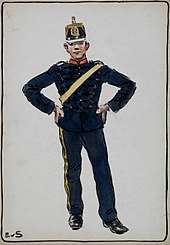Vaxholm Artillery Corps
| Vaxholm Artillery Corps | |
|---|---|
| Vaxholm artillerikår | |
 | |
| Active | 1889–1901 |
| Country | Sweden |
| Allegiance | Swedish Armed Forces |
| Branch | Swedish Army |
| Type | Artillery |
| Role | Fortress artillery |
| Size | Corps |
| Part of | 4th Military District, 4th Division |
| Garrison/HQ | Vaxholm Fortress, Oskar-Fredriksborg Fortress |
| March | "Honnör för Finska gardet" (Arnoldsson)[1] |
Vaxholm Artillery Corps (Swedish: Vaxholms artillerikår) was an artillery unit of the Swedish Army which operated between 1889 and 1901. The unit was based in Vaxholm in Uppland.
History
Vaxholm Artillery Corps, the first fortress artillery corps in Sweden,[2] originated in 1794 from a company of Svea Artillery Regiment (No 1) placed in Vaxholm, which together with the fortress company of Göta Artillery Regiment (No 2) formed Vaxholms Artillery Corps (No 5) on 1 January 1901 after a parliament decisions two years earlier.[2][3][4] The corps was located at Vaxholm Fortress and Oskar-Fredriksborg Fortress on Rindö and consisted of 23 officers, 25 non-commissioned officer, two civilian and 400 men divided into four companies.[2] The crew was enlisted with the addition of military men from the coast of Roslagen and Stockholm.[4] Its commanding officer was also commandant at both fortresses, belonged to the 4th Military District and the 4th Division.[2]
The uniforms was those for artillery, with a few modifications.[2] The color of the collar of the atilla was red. Vaxholm Artillery Corps changed designation in 1892 to No 8 and the color of the collar became white in the design for the fortress artillery (half the collar with lace).[3] For entry into the corps and promotion to lieutenant, similar regulations applied as for the field artillery. The crew was enlisted for 2 years, but could recapitulate. The training of underbefäl (non-commissioned officers) took place in the corps, but the officers' preparatory studies for entry into the Artillery and Engineering College was taught at Svea Artillery Regiment's school in Stockholm.[2]
On 12 December 1901 the corps was dissolved and was terminated from the artillery, to form Vaxholm Coastal Artillery Regiment (KA 1) in the coastal artillery on 1 January 1902.[3]
Commanding officers
Commanding officers from 1888 to 1901:[5]
- 1888–1896 – Hugo Wennerholm
- 1896–1901 – Oskar Sylvander
Names, designations and garrison

| Kungl Vaxholms artillerikår | Royal Vaxholm Artillery Regiment | 1889-01-01 | – | 1901-12-31 |
| No 5 | 1889-01-01 | – | 1892-12-31 |
| No 8 | 1893-01-01 | – | 1901-12-31 |
| Vaxholm Fortress (G) | 1889-01-01 | – | 1901-12-31 |
| Oskar-Fredriksborg Fortress (G) | 1889-01-01 | – | 1901-12-31 |
| Rindö (G) | 1889-01-01 | – | 1901-12-31 |
See also
References
| Wikimedia Commons has media related to Vaxholm Artillery Corps. |
- ↑ Sandberg, Bo (2007). Försvarets marscher och signaler förr och nu: marscher antagna av svenska militära förband, skolor och staber samt igenkännings-, tjänstgörings- och exercissignaler (in Swedish) (New ed.). Stockholm: Militärmusiksamfundet med Svenskt marscharkiv. p. 210. ISBN 978-91-631-8699-8. LIBRIS 10413065.
- 1 2 3 4 5 6 Rosén, John; Westrin, Theodor, eds. (1893). Nordisk familjebok: konversationslexikon och realencyklopedi innehållande upplysningar och förklaringar om märkvärdiga namn, föremål och begrepp (in Swedish). 17. Stockholm. p. 421. LIBRIS 78095.
- 1 2 3 Holmberg, Björn (1993). Arméns regementen, skolor och staber: [en uppslagsbok] : en sammanställning (in Swedish). Arvidsjaur: Svenskt militärhistoriskt bibliotek (SMB). pp. 28–29. ISBN 91-972209-0-6. LIBRIS 7796532.
- 1 2 Westrin, Theodor, ed. (1921). Nordisk familjebok: konversationslexikon och realencyklopedi (in Swedish). 31 (New, rev. and rich ill. ed.). Stockholm: Nordisk familjeboks förl. p. 926. LIBRIS 8072220.
- ↑ Kjellander, Rune (2003). Sveriges regementschefer 1700-2000: chefsbiografier och förbandsöversikter (in Swedish). Stockholm: Probus. p. 324. ISBN 91-87184-74-5. LIBRIS 8981272.